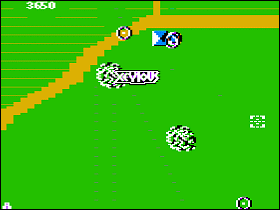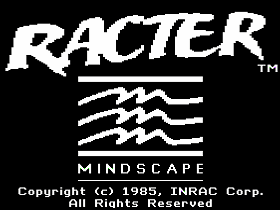Xevious
 The Game: As the commander of a sleek Solvalou fighter, you’re deep into enemy territory, shooting their disc-shaped fighters out of the sky, bombing ground installations and artillery nests,bombing tanks, and trying to destroy the mothership. As you progress further behind enemy lines, heavier aircraft and more versatile and deadly ground-based defenses become the norm. (Mindscape, 1983)
The Game: As the commander of a sleek Solvalou fighter, you’re deep into enemy territory, shooting their disc-shaped fighters out of the sky, bombing ground installations and artillery nests,bombing tanks, and trying to destroy the mothership. As you progress further behind enemy lines, heavier aircraft and more versatile and deadly ground-based defenses become the norm. (Mindscape, 1983)
Memories: In the arcade, Xevious ushered in a whole new genre of vertical-scrolling shooters, a category that would grow to include hits like 1942, Dragon Spirit and Exed Exes – it would actually become a pretty crowded field. But the graphics and sound hardware of the Apple IIe, using a command set grandfathered in from the late ’70s, wasn’t exactly ideal for this new genre. [read more]

 The Game: The player engages in conversation with RACTER (short for raconteur) in normal English sentences via the keyboard. RACTER responds with phrases that may (or may not) be relevant and may (or may not) make sense as part of a cohesive conversation. (Mindscape, 1985)
The Game: The player engages in conversation with RACTER (short for raconteur) in normal English sentences via the keyboard. RACTER responds with phrases that may (or may not) be relevant and may (or may not) make sense as part of a cohesive conversation. (Mindscape, 1985) The Game: Your sleek spacecraft is launched from a base installation on Halley’s Comet (!). Your mission is to scout various bodies in the solar system – both planets and moons – which meet strictly defined criteria as dispensed by the computer. In some cases you must land, in others you must simply achieve orbit. You must learn to navigate the solar system using the constellations of the Zodiac, and learn to judge distance so you won’t overshoot your target (and therefore exceed your allotted mission time) with brief bursts of your faster-than- light drive. You climb in the ranks as you complete more missions. (Interscope, 1986)
The Game: Your sleek spacecraft is launched from a base installation on Halley’s Comet (!). Your mission is to scout various bodies in the solar system – both planets and moons – which meet strictly defined criteria as dispensed by the computer. In some cases you must land, in others you must simply achieve orbit. You must learn to navigate the solar system using the constellations of the Zodiac, and learn to judge distance so you won’t overshoot your target (and therefore exceed your allotted mission time) with brief bursts of your faster-than- light drive. You climb in the ranks as you complete more missions. (Interscope, 1986)